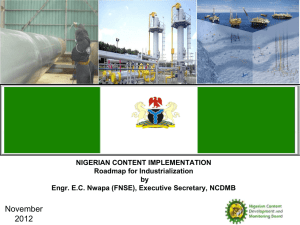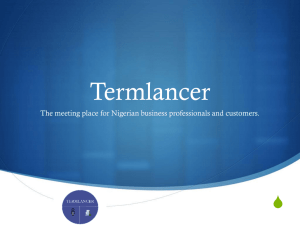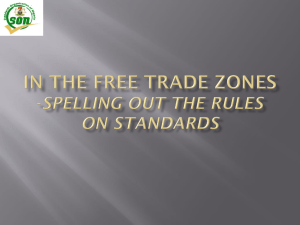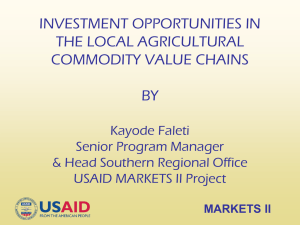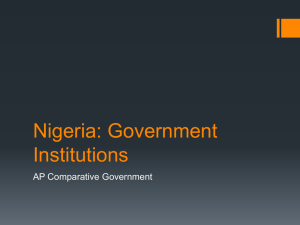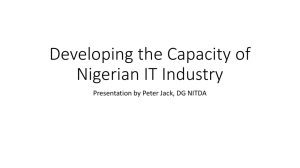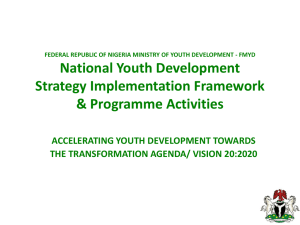Click here to Report in Powerpoint Format
advertisement
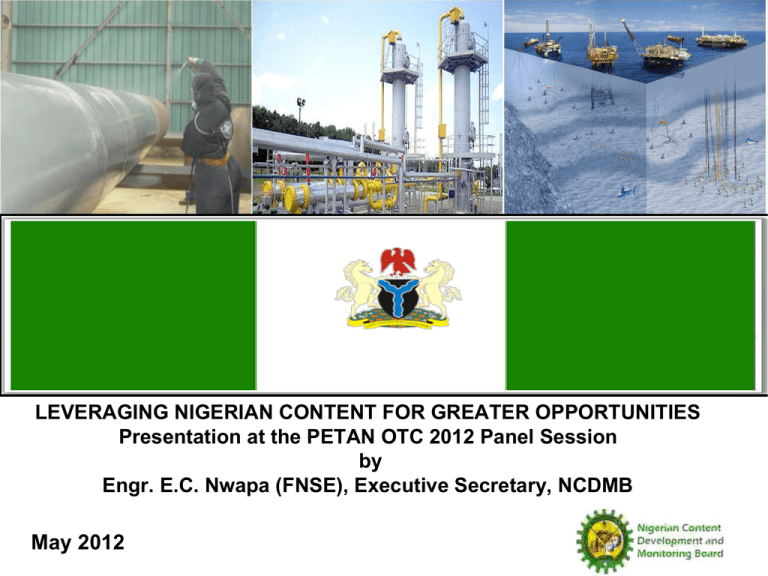
LEVERAGING NIGERIAN CONTENT FOR GREATER OPPORTUNITIES Presentation at the PETAN OTC 2012 Panel Session by Engr. E.C. Nwapa (FNSE), Executive Secretary, NCDMB May 2012 NATIONAL REVENUE PROFILE Over Dependence on Oil A Threat to Oil will threaten National Survival Oil & Gas Industry is repositioning to Promote Utilization of Local goods & Services Building capacity on the back of mega Projects and Operations Other Linkage sectors need to be mobilized Distribution of Oil and Gas Assets. Foreign Vs Indigenous Indigenous players positioned to be in the league of High Performance Energy Companies (HPEC) More fields ready for indigenous players - OML 26,30,34, 40 & 42 DPR: Oil blocks in Nigeria Majors allocating oil fields for Full Field Development using local capabilities as part of R&D program Snapshot of reserves: Oil-36.22 billion barrels (2.92% of world reserves) Gas- 178 TCF (2.98% of the world reserves) 1.6 Majors • Addax, Chevron, Eni-Agip, Exxon Mobil, Shell and Total • Control 98% of reserves and production assets 2.Indigenous companies • Over 30 operators (Afren, Oando, Seplat etc) • Over 30 independents and local operators ( Summit, Conoil etc) • Own 2% of reserves NDPR 1. Combined daily production capacity of 80,000 bpd 2. With aggressive equity participation indigenous players will increase market share 3. NPDC making significant progress , hitting the 100 barrels per day equivalent mark. 4. Full Field Development by indigenous companies being promoted Changing the Pre – NOGICD Act Footprint Bringing Nigerian Jobs Back Pre-Nigerian Content Implementation 2006- 2020 Nigerian Content the Implementation Defining Roadmap for Change Buying rather than selling. Exporting Nigerian Jobs Estimated capital flight $380 billion Estimated lost job opportunities 2 million Bringing Nigerian Jobs Back Hub for oil and gas services Estimated $191 billion could be retained 300,000 new direct job opportunities -(Engineering, Sciences, Technicians etc) $14b $78b Technical Services $39b $20b Fabrication $20b $39b Engineering $214b $107b Procurement $9b $7b Research & Development Over 95% of industry spend Abroad 30yrs 10yrs Over 65% of industry spend domiciled Introduction of the Nigerian Content Act Signed into law by Mr. President in April 22 2010 Established the Nig Content Devt and Monitoring Board Inaugurated Governing Council for the Board August 2010 NCDMB commenced operations in Yenagoa in June 2010 NCDMB has steered non-disruptive implementation for 2 years Thrust of the NOGIC Act 2010 Nigerian Content aspiration derived from the thrust of the NOGIC Act are focused on ensuring that companies benefitting from our natural resources also contribute to economic development of Nigeria . 1 Maximize utilization of Nigerian made goods • Develop local capacity in key areas such as manufacturing fabrication, engineering etc • Promote indigenous ownership of assets and utilization of indigenous assets in oil and gas operations 2 Maximize utilization of Nigerian human resources • Develop indigenous skills pool across oil and gas value chain • Provides mandatory training requirements on the back of projects • Creates JQS to manage and track available skills 3 Link the oil and gas industry with other sectors • Promote establishment of support industries that will sustain oil and gas industry of the Economy operations • Enhance multiplier effect of oil and gas investments in economy 4 5 Focus on community participation in the supply chain Foster institutional collaboration • Develop pool of competitive supply chain rooted in oil bearing communities • Create customized training and sustainable employment opportunities • structured awareness and enlightment campaigns • Institutionalize inter-agency collaboration on local content development • Integrate NCDMB into planning and contracting process to ensure Nigerian Content COUNTS • Dedicated NCDF for capacity building HMPRs Medium Term Targets - 2010 to 2015 Retain $10 billion out of $20 Billion average annual industry spend Create over 30000 direct employment and training opportunities Establish 3 to 4 pipe mills to service industry demands Develop 1 or 2 dockyards and maximize use of existing shipyards Increase indegenous ownership of marine assets to 60% minimum Integrate indigenes and businesses in the oil producing areas Capture 50 to 70 % of banking, insurance and legal services NIGERIAN CONTENT ROAD MAP Realizing the Vision – Instrument for the industrialization of Nigeria R&D Steel mills Facility / upgrades Human Capital Dev Rig/vessel owner Dry dock/shipyard Manufacturing/ Assy Manufacturing/assembly A MULTI LANE HIGHWAY TOWARDS INDUSTRIALISATION Various Initiatives in: i) R&D ii) Human Capital development iii) Steel Pipemills and associated industries iv) Manufacturing and Component Assembly v) Marine Vessel and Rig Ownership vi) New facilities and Upgrade of existing infrastructure vii) Dry Docks and Shipyards Stakeholder Collaboration Implementation Model Investment policy Contracts approval Bid rounds NCDF Capacity development NC regulation Interministerial Interface- RMRDC on R&D Government Nigerian content scope on projects (NCCC) Capacity development 1% remittance to NCDF Oil companies Service providers International partners Foreign Direct Investment Benchmark models (learning from others) Nigerian Content Consultative Forum (NCCF) Capacity development Nigerian Content Equipment Certificate (NCEC) 1% remittance to NCDF NCDMB act as facilitator, bringing together a broad array of Implementation challenges • Strict compliance without disrupting industry activities – Capacity Gaps • Handling increased cost + schedule • Transparent effective model for NCDF Management • Ensuring Quality of delivery • Absence of manufacturing capability and confidence to use local goods• Extending implementation to Downstream • Growing new organization to meet wide responsibility • Funding the Boards operations from appropriation • Interface • Exposure to frequent litigation Nigerian Content Roadmap developed to manage challenges , deepen capacity and maximise utilisation of Nigerian goods and services Nigerian Content Measurement Partial NC Based on proportion of value of contracts awarded to Nigerian Companies • • • • Real NC Based on proportion of contract sums spent on Nigerian made goods NC VALUE NC VALUE (70% - 85%) (12% - 18%) There is marked increase in contract award to Nigerian companies Spend proportion in Nigeria has peaked Without manufacturing, no further NC Growth No employment growth Current Performance levels 100 80 90% 60 50% 40 20 7% 0 Engineering Fabrication Manufacturing NCDMB adopts 3 pronged approach to promote utilization of locally Manufactured goods • Issued Research and Development guidelines to industry operators & service providers • • Enforcing compliance with provisions and schedule of Act on material utilization on projects and operations • Promoting local manufacture of materials used in the industry COST BENCHMARK TEMPLATE FOR LOCAL MANUFACTURING Imported Pipes Value abroad Cost allocation Locally Manufactured Pipes Local input Cost element 1 Raw Material (imported) 2 Raw Material (local) 3 Custom Duties 4 Excise Duties 5 Taxes 6 Inland transport ( port to factory) 7 Inland Transport Factory to site 8 Finance costs (foreign) 9 Finance costs (local) 10 Wages 11 Amortization for equipment 12 Power generation Locai Input Cost allocation In country Value Remarks STRATEGIC INTERVENTIONS Asset Ownership …. Status of Marine Vessels Utilization Pre NOGIC • Domination of foreign crew men and rig operators • Ownership of vessels and rigs lies with foreigners ~$3 billion in capital flight Today • Indigenous players dominate category 1 vessels –retention of $1.8 billion • Structured intervention for more Nigerian ownership of category 2 vessels- potential for retention of >$1.5 billion 2+1yr Contracts Low Cost Highest spend is on category 2 vessels – AHTs/LHTs, DP PSVs, DSVs, Pipe Lay Barges Operators have put in place robust plan to replace foreign owned with indigenous owned vessels. 26 STRATEGIC INTERVENTIONS Training & Employment Social Employment PUBLIC SECTOR (Regulator) ~30,000 jobs Compared to rising prices of oil, the capacity of operating companies to employ nationals has been on the decline since 2008 INTERVENTIONS: SERVICE PROVIDERS (Services, equipmt) <1 million jobs OPERATOR (Opportunities and finance) ~25,000 jobs 1.(NOGETTS) Project Based Training and Attachment • Over 6,000 candidates captured on JQS Platform • Over 1,500 attached to O & G Projects • Developing geosciences Training • Developing environmental remediation training 2.Institutional Development - LINKAGE INDUSTRIES (Manufactrg) >2 million jobs • Established OGTAN • Establish Engineering Academy with PPP • NIW Welding Technology Complex (NIW/NCDMB/Shell) Productive Employment • Establish Subsea Academy 3.Expatriate Quota Management • EQ allocation supported by robust succession planning • Monitor utilisation of EQ slots TYPICAL PROJECT SPIN-OFFS FPSO topside Integration capability Subsea Training & Certifying Academy Subsea Equipment Manufacturing Capability Heavy Industry Fabrication Yard - $ 250million Legacy Programs. EGINA/GAS MP/ BONGASW/ERHA NORTH/BRASS LNG FPSO Topside Integration Facility •TUPNI committed to EGINA topside integration •Integration Facility set by 2014 Pipe Mills •Consolidate existing Mill •3 new Pipe mills •Start Production by 2015 •Cost of $150m each •Cost of $150m to $200m • Generate 15000 Jobs •Generate 30000 jobs •3000 training opportunities •Training opportunities Dock Yards Subsea Equipment Manufacturing Complex •NLNG, BLNG focus •Erha North/ Egina •LNG carrier size Dockyard •Umbilical facility & Tree assy •Complete by 2015 •Start Production by 2015 •Cost of $250m •Cost of $250m each • Generate 55000 Jobs • Generate 5000 Jobs •20 000 training opportunities •2000 training opportunities STRATEGIC INTERVENTIONS Indigenous Marine Vessels Utilization Category 1 Marine Vessels Ownership Economic and Technical Benefits •Issued guidelines for utilization and •Impact on the economy Categorization Category 2 •Obtained commitments for replacement •Retention of Nigerian jobs in marine of crew foreign vessels extracted from operators. Category 3 •Directed marine providers, to upload •Growth of indigenous capacity and details of vessel fleet unto NOGIC JQS sustainability of services •Organized •Impact in linkage industries – merchant workshop with marine providers to establish opportunity shipping, Ports development and Utilization •Mandate vessel providers to carryout maintenance in Nigerian yards 27 STRATEGIC INTERVENTIONS Offshore Rig Acquisition Strategy Indigenous Rig Acquisition Land Rig •Mandate Use of Nigerian Operating Company for Contracting. •Domicile equipment and technology in the Company. Jack up Rigs •Phased increase in indigenous equity to meet Acts requirement of 50%. •Assistt with long term funding and equity Financing Semi subs/ Drillships 28 STRATEGIC INTERVENTIONS Line Pipe Mill Pilot Scheme PILOT SCHEME DESCRIPTION Site Map 2500km of pipe Replacement of vandalised and aged pipelines Proposed Layout Water distribution projects Partnership roles NCDMB – Buy Land (SPV) Shell + Operators - (Jetty) Yulong - Equipment STRATEGIC INTERVENTIONS Equipment Components Manufacturing Industry guideline mandates all OEMs to domicile manufacture of equipment components, parts, packages and systems in Nigeria Equipment Parts Equipment Packages Growth Components and Frames 2011 to Year 2017 STRATEGIC INTERVENTIONS Nigerian Content Equipment Certificate (NCEC) •The Board is issuing NCECs to companies that have met the requirements •About 52 applications being processed •IOCs are taking initiatives to support OEM presence in Nigeria •Guidelines issued to the industry making NCECs a requirement in tenders STRATEGIC INTERVENTIONS Nigeria Oil & Gas Industry Content Joint Qualification System NOGIC JQS • Expatriate Quota Utilization and Succession data • Marine Vessels data • Contract Processing data • Equipment Ownership • Nigerian Content Compliance Certificate Data • Skill Base Tracking 1.Categorization of oil and gas service companies 2.Industry data base for skills verification. 3.Verification of available in-country capacity 4.Effective information exchange across stakeholders • Training and Employment data 5.Compliance Monitoring • Nigerian Content Plans and 6.Test data uploaded reports repository 7.Launch Q2 2012 Nigerian Content Development Fund Model (Clause 104 of the Act) Letter on NCDF implementation 30% NCDF Direct Intervention Lte 70% 1% Upstream contract sums Guarantee Ltd Direct Capacity Development intervention by the Board Equity Participation to stimulate Investments in Critical facilities Industry Advisory Committee Fund Managers (BGL/UBA global) Skills Development & Job Creation interventions Provide Guarantees for low interest lending Industry Advisory committee & SPV to strengthen Governance Fund will not be depleted Other Participating Commercial Banks Nigerian Content Governance on Monitoring ….COMES COMPLIANCE MONITORING & ENFORCEMENT STRATEGY ( COMES) THIRD PARTY INSPECTION TASK FORCE Legal firm Engineering firm Accounting/ Audit Firm/Forensic Auditor Engineers, Geologists, Subject matter specialist Industry experienced professional NCDMB Personnel 35 36 INSISTENCE ON COMPLIANCE HAS CREATED FACILITIES BK TUBULARS – OCTG THREADING FACILITY Before Today INSISTENCE ON COMPLIANCE HAS CREATED FACILITIES TOTAL PREMIER – OCTG Welding/Threading Facility April 2011 January 2012 IT IS WORKING NIGERDOCK – Drydock and Fab Yard BEFORE TODAY IT IS WORKING GLOBESTAR – invested in new fabrication capability SAIPEM FAB YARD New NC work scope required over $100 million jumbo yard TODAY BEFORE IT IS WORKING ONNE FZ – Offshore Logistics Base BEFORE TODAY Hub for logistics and industry services for Nigeria and GoG LADOL – Offshore Logistics Base BEFORE TODAY Major service PROGRAMS & ACHIEVEMENTS Programs Scope Achievements Benefits Indigenous ownership of Assets Marine Vessels ownership and utilization, Cabotage compliance Ownership Manning Maintenance Utilization Rigs ownership and utilization Ownership Manning Maintenance Utilization Equipment ownership and utilization Minimum of 50% ownership of equipment to execute projects by indigenous company or Nigerian subsidiary 85% of category 1 vessels in operation owned by Nigerians these include crew supply vessels, mooring launch vessels, shallow draft vessels etc Firm commitment from operators to replace 49 foreign category 2 vessels with Nigerian owned. of foreign category 2 vessel with Nigerian owned Established vessel maintenance capability Dry-docking facility at NigerDock ( the largest in West Africa ) $1.8Bn out of &3.5Bn spend retained in the Nigerian economy Retention of over 3,800 jobs and creation of about 300 new jobs Stimulus for investment in dry dock and shipbuilding facility Guidelines issued to industry on onshore and offshore rigs ownership and utilization Achieved Indigenous ownership of certain rig types -semi-submersible , swamp and land rigs (Oando, Seawolf, Bell Oil and Gas) Retention of about $500 million in the economy Indigenous companies with capability and which own equipment used in their operations are now exclusive players in land and swamp Indigenous companies with equipment and subsidiaries of multinationals which own minimum of 50% of equipment used are allowed to bid for offshore work Indigenous companies have developed capacity and now have a say as major stakeholders in partnerships with multinationals Retention of over 50% of spend from projects executed in the Nigerian economy PROGRAMS & ACHIEVEMENTS Programs Scope Achievements Next steps (6 months) Domiciliation of Equipment component manufacturing Public notice to industry, to submit domiciliation plan for equipment component manufacturing Significant progress with concrete plans for domiciling manufacture of equipment components -52 applications for NCEC within 7 months Operators are developing their own framework to promote and encourage OEMs to set up manufacturing facilities in Nigeria, in line with the principles of the ECM Monitor implementation of domiciliation plan. Increased utilization of existing HSAW pipemill by industry (over 100km of steel pipe being serviced by SCC Abuja ) Firm commitment received from 2 investors to set up facility –Yulong 250,000Mt LSAW, Vigeo 200,000Mt HSAW Steer industry to put more work in SCC Manufacturing Equipment Components Manufacturing (ECM) Initiative Nigerian Content Equipment Certificate (NCEC) Steel pipemill scheme Maximize utilization of existing facility Promote establishment of pipemills Hold stakeholder workshop to elicit consensus on implementation of ECM initiative Monitor project development activities for new pipemills Support direct investments where necessary Local manufacture of Promote utilization of at drilling mud least 60% of barite needs of the industry from Nigerian deposits Structured collaboration with AMAPOB on local manufacture of barites Promoted studies by SGS to validate quality of Nigerian barite deposits as meeting industry standards Steer industry to source barites from Nigeria PROGRAMS & ACHIEVEMENTS Programs Scope Achievements Establishment of a private sector led center for skills development and international certification in the field of engineering Project concept put together for engineering training center of excellence Packaged geosciences training to train critical skill requirement in the industry Completed first set of welders training Benefits Training Infrastructure development, training and employment opportunities Direct facilitation of training in critical industry skill requirements Oversight on project based training opportunities In country training facilities for oil and gas type skills Manage capital flight associated with offshore training Knowledge transfer 1000 candidates to be trained on environmental management Retention of at least 30% of environmental remediation budget in community Over 500 candidates trained on the back of oil and gas projects – welding, Packaged environmental pipefitting, scaffolding, engineering design remediation training to address etc. recurring environmental challenges Over 50% trainees have been placed on sustainable employment Industry is already promoting foreign trainers to conduct critical trainings in Nigerian facilities Nigeria Institute of Welding New multimillion dollar facility Will provide certification for welders and modelled after International Institute weld integrity tests on projects of welding with capacity to certify. PROGRAMS & ACHIEVEMENTS Programs Scope Achievements Next steps (6 months) Supplier Development Nigerian Content Development Fund (NCDF) Partial guarantee -70% Direct investment -30% Guidelines on remittance developed; remittance of 1% ongoing NCDF operating model developed and discussed with CBN Selected 3 service companies for pilot implementation -partial guarantee facility 2 SPVs incorporated to oversee the NCDF on behalf of the Board Obtain approval to launch pilot scheme –partial guarantee facility Nigeria Oil & Gas Industry Content Joint Qualification System NOGIC JQS Data base for industry skills, capacity and project opportunities Built NOGIC JQS infrastructure in Yenagoa Manage test phase and Disaster Recovery Center in Abuja Prepare for launch Engaged stakeholders and obtained feedback from end users Go live event held in August 2011 PROGRAMS & ACHIEVEMENTS Programs Scope Achievements Benefits Some Infrastructure Development & Facility Upgrade Saipem fabrication (Tier 1) Fabrication yard upgrade Nigerdock fabrication (Tier 1) Fabrication yard upgrade Globestar fabrication (Tier 1) Fabrication yard upgrade Dormanlong Fabrication yard upgrade Training facilities Heavy Fabrication and Subsea training facility/Academy Completed yard expansion project (jumbo yard) Capability for high tonnage fabrication and lead-out Retention of existing jobs In-country capability for fabrication, dry Established and commissioned largest docking, training and maintenance. dry docking facility in West Africa Technology transfer Acquired capability for high single Retention of spend associated with ship tonnage fabrication and lead-out. repairs and maintenance Major aspiration/project launched for Creating ship repairs industry within deep offshore skill base with FPSO Nigeria to service vessels operating in integration capacity. Expected completion Nigeria and West Africa. - 2015 Employment generation Fabricated first subsea tree frames and Capability for high single tonnage subsea modules in Nigeria fabrication and lead-out Retention of existing jobs Self sufficiency in domestic supply Obtained certification for pressure Local facility maintenance capability vessels manufacture Established Nigerian foot prints in West Fabricated pressure vessels for IOCs Africa including Shell Gabon Over 10,000 jobs to be created. Installed major galvanizing facility serving Retention of about $5.4 billion from FPSO LNG and telecommunications industry value chain Private sector led training facilities for Oil Hyundai establishing a fabrication and Gas skills training academy Akersolutions to setup subsea acadey

